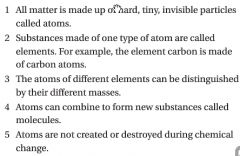![]()
![]()
![]()
Use LEFT and RIGHT arrow keys to navigate between flashcards;
Use UP and DOWN arrow keys to flip the card;
H to show hint;
A reads text to speech;
44 Cards in this Set
- Front
- Back
|
atom |
very simplest of particle |
|
|
molecules |
groups of atoms |
|
|
chemical reaction |
atom rearrange to form new substances |
|
|
reactants |
starting substances of chemical reaction |
|
|
products |
substance that is formed |
|
|
spontaneous reaction |
chemical reaction that need energy at the beginning and then continue themselves |
|
|
arrow meaning |
reactant becomes product |
|
|
iron corrosion equation |
iron + oxygen = iron III oxide |
|
|
atomic theory principals
|
all matter is made up of hard tiny invisible particles called atoms substances made of one type of atom are called elements the atoms of different elements can be distinguished by their masses atoms can combine to form molecules atoms are not destroyed or created during chemical change |
|
|
how many atoms int he world |
100 |
|
|
metallic properties |
solid at room temp except mercury shiny conduct heat and electricity malleable stretched (ductile) |
|
|
non metallic properites |
dull do not conducts heat or electricity break or crumble when bent |
|
|
atomic theory |

|
|
|
how many types of atoms |
100 |
|
|
metallic element properties |
shiny solid at room temperature conductors of heat and electricity malleable ductile stretch |
|
|
metallic elements examples |
copper gold iron silver |
|
|
non metallic properties |
dull can't conduct electricity or heat brittle |
|
|
how many elements |
118 |
|
|
how many elements are natural |
91 |
|
|
atoms in elements |
single atoms monatomic cluster of atoms molecules large grid structure lattice |
|
|
monatomic elements |
an element that consists of just single atoms |
|
|
molecular elements |
identical size and shape and number and type of atom two or more atoms bonded together |
|
|
metal lattices |
makes metals strong and solid at room temp atoms can slide and move over each other, so metal can be bent |
|
|
non metallic latices |
bonded strongly together which makes them hard and brittle |
|
|
compounds |
substances made from more than one type of atom |
|
|
molecular compuinds |
=size shape and number of atoms |
|
|
compound lattices |
atoms bonded very strongly eg salt beach sand |
|
|
mixtures |
combination of elements and compounds |
|
|
gaseous mixtures |
any two gases can be mixed easily because the particles are spread wide enough solids can be mixed, e.g. ash floating in air liquids can be mixed, e.g. mist |
|
|
miscible |
liquids that can be mixed, e.g. food colouring and water |
|
|
immiscible |
liquids that don't mix oil and water |
|
|
Alloys |
mixture of a metal with another metal or non metal iron and carbon make steel |
|
|
atomos |
atoms |
|
|
atomic theory |
l matter is made from indivisible particles called atoms elements are made from one type of atom compounds are made from more than one type of atom atoms cannot be destroyed or created during chemical change |
|
|
subatomic particles |
smaller particles than atoms |
|
|
protons |
positively charged |
|
|
neutrons |
no charge |
|
|
electrons |
negative charge |
|
|
nucleus |
centre of atom where protons and neutrons are |
|
|
charge of an atom |
the charge of an atom is 0 as they is an even number of electrons and protons |
|
|
atomic number |
number of protons in an atom |
|
|
mass number |
number of protons and neutrons in atom |
|
|
electron shells |
broken down electron cloud determines how many electron can be held in each one |
|
|
electron shell amounts |
innermost : 2 second : 8 third : 18 fourth :32 |

